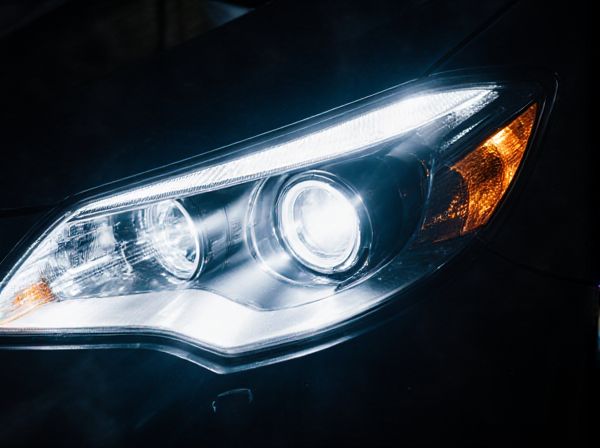
Photo illustration: Halogen Headlight vs Xenon Headlight
Halogen headlights emit a warm, yellowish light that is cost-effective and easy to replace, offering reliable performance for everyday driving. Xenon headlights provide brighter, whiter light with a longer lifespan and improved visibility, particularly in low-light conditions, enhancing safety on the road. Choosing between halogen and xenon depends on your budget and preference for light intensity and clarity.
Table of Comparison
| Feature | Halogen Headlight | Xenon Headlight |
|---|---|---|
| Light Source | Tungsten filament with halogen gas | Xenon gas arc discharge |
| Brightness | Up to 1,500 lumens | Up to 3,500 lumens |
| Color Temperature | 3,000 - 3,200 K (yellowish white) | 4,000 - 6,000 K (bright white to bluish white) |
| Energy Efficiency | Lower efficiency, higher power consumption | Higher efficiency, lower power consumption |
| Lifespan | 500 - 1,000 hours | 2,000 - 3,000 hours |
| Cost | Affordable, low initial cost | Higher upfront cost |
| Warm-up Time | Instant illumination | 2-3 seconds warm-up |
| Installation | Simple, direct replacement | May require ballast and professional installation |
Introduction to Headlight Technologies
Halogen headlights utilize tungsten filament bulbs emitting warm, yellowish light commonly found in standard vehicles due to their affordability and ease of replacement. Xenon headlights, also known as High-Intensity Discharge (HID) lamps, produce brighter, bluish-white light by creating an electric arc between electrodes in a xenon gas environment, offering improved visibility and energy efficiency over halogens. Modern automotive lighting increasingly favors xenon technology for enhanced road illumination and longer lifespan.
What Are Halogen Headlights?
Halogen headlights use a tungsten filament enclosed in a glass bulb filled with halogen gas, producing light through incandescent heating. They are widely favored for their cost-effectiveness, ease of replacement, and compatibility with most vehicle systems. Despite emitting a warm yellowish light with moderate brightness and shorter lifespan compared to xenon headlights, halogen bulbs remain a common choice for everyday driving conditions.
What Are Xenon (HID) Headlights?
Xenon (HID) headlights use high-intensity discharge technology that produces a bright, white-blue light by igniting xenon gas within the bulb, offering superior brightness compared to halogen headlights. These headlights deliver greater luminosity and energy efficiency, enhancing nighttime visibility and reducing eye strain for drivers. Xenon headlights also have a longer lifespan, typically lasting up to 2,000 hours, which surpasses the average halogen bulb duration.
Key Differences Between Halogen and Xenon Headlights
Halogen headlights use tungsten filaments heated to emit light, producing a warm yellowish glow, while Xenon headlights utilize high-intensity discharge (HID) technology with xenon gas to create a brighter, whiter light that improves visibility. Halogen bulbs are generally less expensive and easier to replace, but they have shorter lifespans and lower energy efficiency compared to Xenon bulbs, which provide longer-lasting performance and consume less power. Xenon headlights also offer enhanced brightness and a wider field of illumination, making them superior for nighttime driving and adverse weather conditions.
Brightness and Light Output Comparison
Halogen headlights typically produce a brightness of around 1,000 to 1,500 lumens, providing warm yellowish light with moderate illumination range. Xenon headlights, also known as HID lights, generate a significantly higher brightness output of approximately 3,000 to 3,500 lumens, delivering intense white or bluish light that enhances night visibility and road safety. The superior light output and efficiency of Xenon headlights result in better illumination, longer beam distance, and reduced glare compared to halogen bulbs.
Energy Efficiency: Halogen vs Xenon
Halogen headlights consume more energy due to their incandescent technology, typically using around 55 watts per bulb, which results in less efficient fuel usage in vehicles. Xenon headlights, also known as High-Intensity Discharge (HID) lamps, operate at approximately 35 watts per bulb while producing brighter and whiter light, offering better energy efficiency and longer lifespan. The lower power consumption of xenon lights contributes to reduced electrical load, improving overall vehicle energy management compared to halogen bulbs.
Lifespan and Maintenance Considerations
Halogen headlights typically have a lifespan of around 500 to 1,000 hours, while xenon (HID) headlights offer a longer lifespan ranging from 2,000 to 3,000 hours. Halogen bulbs require more frequent replacements and generate more heat, which can affect housing and wiring over time, increasing maintenance needs. Xenon headlights, although costlier upfront, feature lower heat output and better durability, resulting in reduced maintenance and overall longer-lasting performance.
Cost Comparison: Initial and Ongoing Expenses
Halogen headlights generally have a lower initial purchase price, typically ranging from $20 to $50 per bulb, compared to xenon headlights, which can cost between $100 and $300 each. Ongoing expenses for halogen bulbs include more frequent replacements approximately every 500 to 1,000 hours of use, whereas xenon bulbs last longer, around 2,000 to 3,000 hours, reducing replacement frequency. Maintenance costs for xenon headlights may be higher due to the need for specialized ballasts and installation, making halogen bulbs more economical for budget-conscious vehicle owners.
Safety and Road Visibility Impact
Halogen headlights emit a warm, yellowish light that provides moderate road illumination, but their shorter range and lower brightness may reduce visibility in adverse weather conditions, impacting safety. Xenon headlights, with their brighter, bluish-white light and longer beam distance, enhance road visibility by illuminating a wider area more effectively, improving driver reaction times and overall safety. The superior light output and color temperature of Xenon lights contribute to better contrast and object recognition on the road, reducing the likelihood of accidents.
Which Headlight Is Right for Your Vehicle?
Halogen headlights offer a cost-effective, easy-to-replace lighting solution with a warm color temperature ideal for basic night driving, while Xenon headlights provide superior brightness and a longer lifespan with a cooler, more intense light output that improves visibility in low-light conditions. Choose halogen headlights for budget-friendly maintenance and simple installation, or opt for Xenon headlights if enhanced illumination and advanced vehicle safety features are priorities. Consider your vehicle's compatibility, driving environment, and budget to determine the best headlight technology for your specific needs.
 caratoz.com
caratoz.com